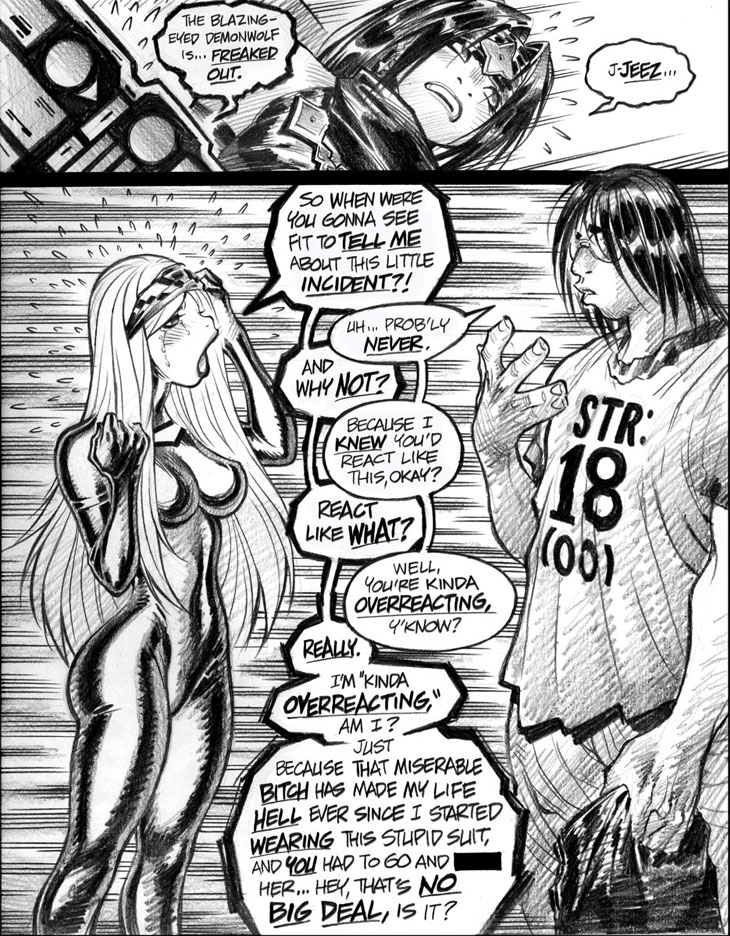As panel 2 features a very rare Empowered example of a particular comics dialogue approach that I ordinarily dislike intensely, for today's commentary I'll paste in an old-ish Twitter rant about said technique, explaining in great detail why I don't care for it. Um, enjoy?
Today's rant: The problems inherent to the common practice of comics writers scripting lengthy exchanges of dialogue within single panels. I'm talking about a long, "ping-ponging", back-and-forth exchange of word balloons over a single image of characters in conversation. I've only belatedly realized that I rarely use such exchanges in Empowered; I can only think of 2 or 3 examples in the series' 2000-odd pages, with this very page being the foremost such example.
This "ping-pong" technique is popular with comics writers fond of snappy patter; it allows for rapid-fire dialogue exchanges in relatively few panels. Howeva, this approach can shortchange the art's narrative role, reducing it to a static illustration accompanying a mass of clever chatter.
Lengthy "ping-pong" dialogue exchanges within a single panel can sometimes diminish or eliminate the artist's opportunity for "acting." By that, I mean the artist giving his or her characters varied, changing facial expressions to match different beats of their dialogue. In a long, 1-panel dialogue exchange, the artist must choosea single facial expression (and body language) for each character and hope for the best. This can lead to problems when characters change tones during a convoluted in-panel exchange, disassociating their dialogue from what the art depicts.
Writers: In each panel, make sure that one facial expression or pose for each character can "carry" (or fit with) all of their dialogue. Example: In a 1-panel dialogue exchange, don't shift a character's speech from calm to angry, as no artist can convey both in a single image. (OK, it IS possible to convey successive emotional shifts within a single panel, but this requires a cartoony approach most would dislike.)
I've seen artists obviously say "Screw it" by just drawing a big ol' panel with plenty of space left open around the characters' wee figures, so the writer's many word balloons can chase each other across the panel, like puppies (of dialogue) at play in an open field. SO CUUUUTE!
I'm not saying that well-written, in-panel dialogue exchanges can't be a whole lotta fun; they certainly can be, given a skilled writer. Some writers have such consummate expertise with dialogue that they can make these exchanges sing; others, well, can't quite make 'em work. The temptation's understandable: Long dialogue chains are very "showy" writing techniques, like double-page spreads can be for artists. But just like artist-driven showmanship can wreck a comic, so too can blatant displays ("Look at my sparkling dialogue!") by flawed writers.
I've spoken to writers who consider "ping-ponging" word-balloon flurries to be defensive measures against less-than-impressive artwork. The idea: Even if the artist does a bad job, the writer's skills can still carry the day through the tone & expressiveness of the dialogue. IMHO, though, comics writers who rely solely on big panels with long dialogue chains are often shortchanging both the artist AND themselves. Mixing things up—by, say, breaking large, dialogue-heavy panels into smaller ones—can get the artist "in the game" and participating fully. An artist contributing meaningfully makes you, the writer, look better than when your dialogue rampages unchecked over uninspired artwork. Worst case: Comics as, in effect, illustrated screenplays or TV scripts, as if the artist is doodling around the dialogue on a script copy.
Short(er) form? Dialogue exchanged over multiple panels is almost always superior to one big panel festooned with chains of exchanged dialogue.
I prefer using more panels (w/fewer word balloons) to depict a dialogue exchange, maximizing the artwork's "acting" possibilities. Howeva, this is a luxury enabled by Empowered's sheer volume of pages, a luxury unavailable to Marvel/DC writers working under severe pagecount limits. On the other hand, Marvel and DC writers earn far, far more for their work than I do, which is luxury of another sort entirely.
Then again, in superhero-team books requiring writers to herd a burgeoning crowd of characters through multiple plot points in only 20 pages, dialogue-exchange chains in single panels are undeniably a useful tool, as most other approaches would tend to burn up too much pagecount. Howeva, some writers default to "ping-pong" exchanges in less defensible contexts: Two folks jawing in a leisurely, action-free scene, say. My biggest problem with "ping-pong" dialogue exchanges: They've become the annoyingly overused "default mode" for too much comics scripting.
My background as a writer/artist might explain my distaste for dialogue-exchange overuse—but maybe not, given recent(ish) comics history. IMHO, the "ping-ponging" dialogue-exchange comics trope: Pioneered by a writer/artist, then later repopularized by another writer/artist. I first encountered rapid-fire dialogue exchanges in Howard Chaykin's immortal (and personally ultra-influential) 1980s comic series American Flagg! (I gather that Claremont did plenty of "dialogue ping-pong" back then, too, but I never read much Claremont. I was all cray about the Chay, yo.) Chaykin's rapidfire exchanges of smart, funny, prickly dialogue were one among many of the groundbreaking innovations in American Flagg! And he took dialogue exchanges a step further with the long, tortuous chains of intertwining word balloons in his later TIME² graphic novels.
Years later, Brian Bendis used a similar—Chaykinesque?—approach to dialogue in his early work as a writer/artist on AKA Goldfish and Jinx. His later (scripting-only) work for Marvel had far more influence in popularizing the technique than did his writer/artist work, of course. Interesting to think, though, that Chaykin & Bendis worked up dialogue approaches as writer/artists that later writers would (over)use & abuse.
End of Twitter rant (repurposed for Empowered commentary)!
-Adam Warren

